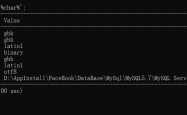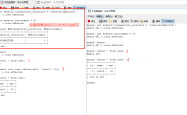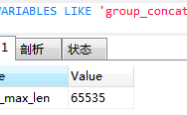简单了解添加mysql索引的3条原则
一,索引的重要性
索引用于快速找出在某个列中有一特定值的行。不使用索引,MySQL必须从第1条记录开始然后读完整个表直到找出相关的行。表越大,花费的时间越多。如果表中查询的列有一个索引,MySQL能快速到达一个位置去搜寻到数据文件的中间,没有必要看所有数据。注意如果你需要访问大部分行,顺序读取要快得多,因为此时我们避免磁盘搜索。
假如你用新华字典来查找“张”这个汉字,不使用目录的话,你可能要从新华字典的第一页找到最后一页,可能要花二个小时。字典越厚呢,你花的时间就越多。现在你使用目录来查找“张”这个汉字,张的首字母是z,z开头的汉字从900多页开始,有了这条线索,你查找一个汉字可能只要一分钟,由此可见索引的重要性。但是索引建的是不是越多越好呢,当然不是,如果一本书的目录分成好几级的话,我想你也会晕的。
二,准备工作
?| 1 2 3 4 5 6 7 8 9 10 11 12 13 14 15 16 17 18 19 20 21 22 23 24 25 26 27 28 29 30 31 32 33 34 35 36 37 38 39 40 41 42 43 44 45 46 47 48 49 50 51 52 53 54 55 56 57 58 | //准备二张测试表 mysql> CREATE TABLE `test_t` ( -> `id` int (11) NOT NULL auto_increment, -> `num` int (11) NOT NULL default '0' , -> `d_num` varchar (30) NOT NULL default '0' , -> PRIMARY KEY (`id`) -> ) ENGINE=MyISAM DEFAULT CHARSET=utf8 AUTO_INCREMENT=1 ; Query OK, 0 rows affected (0.05 sec) mysql> CREATE TABLE `test_test` ( -> `id` int (11) NOT NULL auto_increment, -> `num` int (11) NOT NULL default '0' , -> PRIMARY KEY (`id`) -> ) ENGINE=MyISAM DEFAULT CHARSET=utf8 AUTO_INCREMENT=1 ; Query OK, 0 rows affected (0.05 sec) //创建一个存储过程,为插数据方便 mysql> delimiter | mysql> create procedure i_test(pa int (11),tab varchar (30)) -> begin -> declare max_num int (11) default 100000; -> declare i int default 0; -> declare rand_num int ; -> declare double_num char ; -> -> if tab != 'test_test' then -> select count (id) into max_num from test_t; -> while i < pa do -> if max_num < 100000 then -> select cast (rand()*100 as unsigned) into rand_num; -> select concat(rand_num,rand_num) into double_num; -> insert into test_t(num,d_num) values (rand_num,double_num); -> end if; -> set i = i +1; -> end while; -> else -> select count (id) into max_num from test_test; -> while i < pa do -> if max_num < 100000 then -> select cast (rand()*100 as unsigned) into rand_num; -> insert into test_test(num) values (rand_num); -> end if; -> set i = i +1; -> end while; -> end if; -> end | Query OK, 0 rows affected (0.00 sec) mysql> delimiter ; mysql> show variables like "%pro%" ; //查看一下,记录执行的profiling是不是开启动了,默认是不开启的 + ---------------------------+-------+ | Variable_name | Value | + ---------------------------+-------+ | profiling | OFF | | profiling_history_size | 15 | | protocol_version | 10 | | slave_compressed_protocol | OFF | + ---------------------------+-------+ 4 rows in set (0.00 sec) mysql> set profiling=1; //开启后,是为了对比加了索引后的执行时间 Query OK, 0 rows affected (0.00 sec) |
三,实例
1,单表数据太少,索引反而会影响速度
?| 1 2 3 4 5 6 7 8 9 10 11 12 13 14 15 16 17 18 19 20 21 22 23 24 25 26 27 28 29 30 31 32 33 34 35 36 37 38 39 40 41 42 43 44 45 46 47 48 49 | mysql> call i_test(10, 'test_t' ); //向test_t表插入10条件 Query OK, 1 row affected (0.02 sec) mysql> select num from test_t where num!=0; mysql> explain select num from test_t where num!=0\G; *************************** 1. row *************************** id: 1 select_type: SIMPLE table : test_t type: ALL possible_keys: NULL key : NULL key_len: NULL ref: NULL rows : 10 Extra: Using where 1 row in set (0.00 sec) ERROR: No query specified mysql> create index num_2 on test_t (num); Query OK, 10 rows affected (0.19 sec) Records: 10 Duplicates: 0 Warnings: 0 mysql> select num from test_t where num!=0; mysql> explain select num from test_t where num!=0\G; *************************** 1. row *************************** id: 1 select_type: SIMPLE table : test_t type: index possible_keys: num_2 key : num_2 key_len: 4 ref: NULL rows : 10 Extra: Using where ; Using index 1 row in set (0.00 sec) ERROR: No query specified mysql> show profiles; + ----------+------------+---------------------------------------------+ | Query_ID | Duration | Query | + ----------+------------+---------------------------------------------+ | 1 | 0.00286325 | call i_test(10, 'test_t' ) | //插入十条数据 | 2 | 0.00026350 | select num from test_t where num!=0 | | 3 | 0.00022250 | explain select num from test_t where num!=0 | | 4 | 0.18385400 | create index num_2 on test_t (num) | //创建索引 | 5 | 0.00127525 | select num from test_t where num!=0 | //使用索引后,差不多是没有使用索引的0.2倍 | 6 | 0.00024375 | explain select num from test_t where num!=0 | + ----------+------------+---------------------------------------------+ 6 rows in set (0.00 sec) |
解释:
- id:表示sql执行的顺序
- select_type:SIMPLE,PRIMARY,UNION,DEPENDENT UNION,UNION RESULT,SUBQUERY,DEPENDENT SUBQUERY,DERIVED不同的查询语句会有不同的select_type
- table:表示查找的表名
- type:表示使用索引类型,或者有无使用索引.效率从高到低const、eq_reg、ref、range、index和ALL,其实这个根你sql的写法有直接关系,例如:能用主键就用主键,where后面的条件加上索引,如果是唯一加上唯一索引等
- possible_keys:可能存在的索引
- key:使用索引
- key_len:使用索引的长度
- ref:使用哪个列或常数与key一起从表中选择行,一般在多表联合查询时会有。
- rows:查找出的行数
- Extra:额外说明
前段时间写过一篇博文mysql distinct和group by谁更好,里面有朋友留言,说测试结果根我当时做的测试结果不一样,当时我打比方解释了一下,今天有时间,以例子的形势,更直观的表达出索引的工作原理。
2,where后的条件,order by ,group by 等这样过滤时,后面的字段最好加上索引。根据实际情况,选择PRIMARY KEY、UNIQUE、INDEX等索引,但是不是越多越好,要适度。
3,联合查询,子查询等多表操作时关连字段要加索引
?| 1 2 3 4 5 6 7 8 9 10 11 12 13 14 15 16 17 18 19 20 21 22 23 24 25 26 27 28 29 | mysql> call i_test(10, 'test_test' ); //向test_test表插入10条数据 Query OK, 1 row affected (0.02 sec) mysql> explain select a.num as num1,b.num as num2 from test_t as a left join tes t_test as b on a.num=b.num\G; *************************** 1. row *************************** id: 1 select_type: SIMPLE table : a type: index possible_keys: NULL key : num_2 key_len: 4 ref: NULL rows : 10 Extra: Using index *************************** 2. row *************************** id: 1 select_type: SIMPLE table : b type: ref possible_keys: num_1 key : num_1 key_len: 4 ref: bak_test.a.num //bak_test是数据库名,a.num是test_t的一个字段 rows : 1080 Extra: Using index 2 rows in set (0.01 sec) ERROR: No query specified |
数据量特别大的时候,最好不要用联合查询,即使你做了索引。
上面只是个人的一点小结,抛砖引玉一下。
以上就是本文的全部内容,希望对大家的学习有所帮助,也希望大家多多支持服务器之家。
原文链接:http://blog.51yip.com/mysql/1157.html
1.本站遵循行业规范,任何转载的稿件都会明确标注作者和来源;2.本站的原创文章,请转载时务必注明文章作者和来源,不尊重原创的行为我们将追究责任;3.作者投稿可能会经我们编辑修改或补充。










